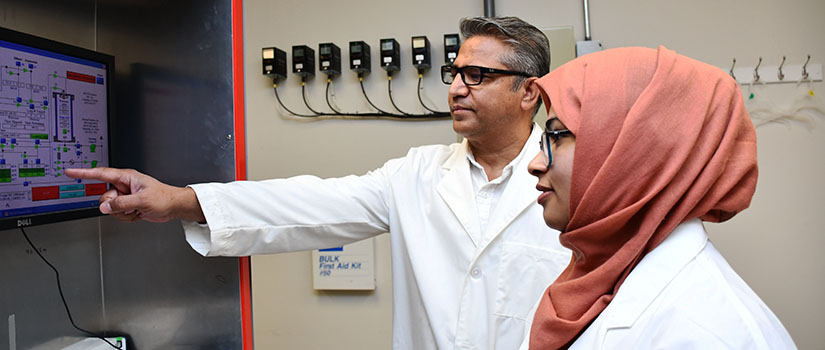Transportation, heavy industry, power transmission and space exploration systems all require electronic components that can operate at large voltages and currents. Wide bandgap semiconductors allow components for these systems to be smaller, faster and more efficient.
Electrical Engineering Assistant Professor Iftikhar Ahmad is currently developing a prototype of devices with a larger bandgap and breakdown voltages to complement or surpass existing technology in energy efficiency. It also intends to impact every segment of industry related to power conversion, storage and transmission, which are linked to all human activity.
Ahmad’s nearly $550,000 National Science Foundation (NSF)-funded research began in early September. Electrical Engineering Distinguished Professor Adel Nasiri will serve as co-principal investigator on the two-year project.
The research is focused on operating ultrawide bandgap semiconductor-based devices at higher temperatures and under harsh conditions. With a higher operating voltage, wide bandgap semiconductors materials, such as gallium nitride (3.4 electron-volts) and silicon carbide (3.26 electron-volts), have started to replace silicon’s narrow bandgap of only 1.12 electron volts. While these materials have properties that allow it to work with high-power devices, Ahmad is currently investigating other materials like gallium oxide with a larger bandgap that can operate even at higher temperatures.
We’re producing an actual prototype of a device and figuring out which one will be the best to take to the next level.
- Iftikhar Ahmad
Ahmad’s previous NSF-sponsored research discovered a better method of growing gallium oxide on sapphire substrate (layer). His research hopes to produce prototype devices with smaller footprints and higher breakdown voltage for operating at elevated temperatures on thermally conducting substrates. Device size is one of the parameters that is always related to the band gap. For example, a larger device is necessary if operating with silicon’s 1.12 electron-volts at a high power. Electronic devices with wider bandgap results in the smaller footprint and higher power to operate at higher temperatures.
“High power and high temperature conditions are used in the electrification of automobiles, trains and airplanes. Since weight could be an issue, if you have smaller devices, the weight will be less and the power consumption will go down,” Ahmad says.
The ultra-wide bandgap materials will be configured into the devices. Ahmad intends to investigate several device configurations and determine which one performs the best for commercialization.
“Working on a different substrate is experimental work which involves a number of parameters. It’s better for us to make several devices with different configurations, operate them and see which one behaves better” Ahmad says.
The research’s outcome will be based on material growth using the more than $1 million facility that Ahmad developed at the University of South Carolina. The NSF award is due to Ahmad team’s successful development of different layers and compositions of high quality ultra-wide bandgap materials in his lab. He will utilize the resources of Georgia Tech’s Nanotech Center for making and fabricating the device and examine the thermal effects and its behavior under different operating conditions.
“We have established a phase stabilized method to grow the materials with bandgap higher than 4.9 electron-volts. This will enable us to create the devices on different substrates. We’ve demonstrated on sapphire substrates and argue that it can successfully be grown on silicon carbide substrates,” Ahmad says.
Since high-power devices generate heat, growing on thermally conducting substrates results in better thermal management. Devices based on ultrawide bandgaps will be compact, lighter and operate at high temperatures. As a result, the power electronics applications can control high voltages and currents, resulting in newer commercial products. The project hopes to develop a new method of making power-electronic devices for diverse applications.
“As high-power devices operate, the large current flows generate a lot of heat. When this happens, the device degrades and ones with a small bandgap degrade at low temperatures,” Ahmad says. “We are trying to grow an ultra-wide bandgap material on a relatively small bandgap as a substrate (silicon carbide) but higher thermal conductivity. This efficiently removes heat and maintains high power operation.”
According to Ahmad, since his team will be creating a high-power device, it is necessary to see the design and how heat is removed. Nasiri will be responsible for that part of the project due to his current work with high power inverters and operating and simulating devices on how heat is generated and removed.
“This project advances the development of ultrawide band gap devices, which will be the backbones of the universal electrification to improve efficiency, increase flexibility and improve reliability,” Nasiri says. “The devices developed will have much higher voltage and current ratings compared with existing wide bandgap devices. They will enable high power and high voltage energy conversion systems.”
The high-power electronic devices will also be commercialized. Once a device is operable and packaged, a startup company will be established through the university’s Technology Commercialization Office to produce, commercialize and sell the devices.
“We had to show [the NSF] that there are industries interested in the technology we develop. If our research is successful, industry can support us and it can be translated to a startup company at USC,” Ahmad says.
Ahmad is excited that the goal of his team’s research is linked to practical applications. His research will also provide postdoctoral researchers and graduate students with entrepreneurial training and interactions with industry.
“The team members get training in not only making devices but the business side and the process for creating a startup company,” Ahmad says. “It’s also nice that this is more than just doing research and publishing the results. We’re producing an actual prototype of a device and figuring out which one will be the best to take to the next level.”
